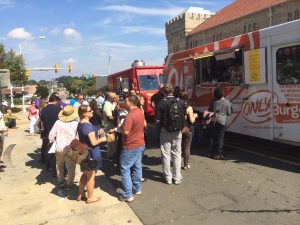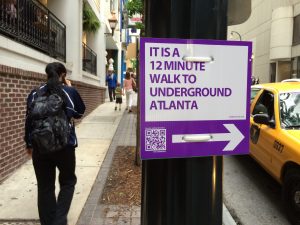|
|
Ambitious Plans and Achievable ActionsBy CED Guest AuthorPublished February 17, 2015City planners like to quote Daniel Burnham, the late-19th century architect and planner. “Make no little plans” he famously said. “[T]hey have no magic to stir men’s blood and probably themselves will not be realized. Make big plans; aim high in hope and work.” That’s all well and good, but those big, unwieldy plans are hard to fund and hard to implement. In recent years, some citizens and planners are taking a different approach. “Do something!” they say. Focus on the small, cheap, and attainable actions. The concept goes by many names—Tactical Urbanism, Better Block Projects, Open Streets, mobile vending, temporary development, and more. Regardless of the name, though, the underlying concept is constant: achieve incremental actions to improve the community. This approach allows for low-cost experimentation; it is like pilot projects for community development. Since 2011, Mike Lydon and several collaborators have catalogued the efforts of various communities in four volumes of Tactical Urbanism, a guidebook with the sub-title “Short Term Action | Long Term Change.” These publications identify many possibilities—converting parking to park space, pop-up retail and cafes, and site pre-vitalization, among others. In March 2015, Lydon and Anthony Garcia will publish a book of the same name. The Better Block Project started in 2010 when neighbors decided to lead a short-term revitalization of an underused commercial block in their Dallas neighborhood. Through their effort, these citizens striped bike lanes, installed temporary trees and lights, and established pop-up businesses and café seating. Since then, communities across the country have replicated the effort. North Carolina communities, too, are exploring Tactical Urbanism, Better Blocks, and the like. Consider the mobile food and temporary development trends around the state. As discussed in a recent CED blog, North Carolina communities are using farmers markets as tools for economic development and food access. Markets can be started with minimal cost and effort. Then, after the market is established, it can migrate to more permanent, more costly space. Food trucks offer a similar option for entrepreneurs to test a business idea for relatively low cost. If the idea succeeds, then the business may move to a bricks-and-mortar restaurant. It is up to local governments to craft rules to support responsible food truck efforts, as discussed more in this CED Blog discusses Food Trucks, Local Regulation, and Community Economic Development. North Carolina communities are experimenting with Better Block Projects, too. In Durham, the Durham Urban Innovation Center teamed up with a local food truck owner for a 30-day temporary revitalization effort. In Greensboro, a collection of community groups conducted a Better Block Project in conjunction with the NC Bike Summit. The project included pop-up stores, new bike lanes, a food truck, art, and music. And one final North Carolina example: Walk Raleigh. This effort of do-it-yourself street signs began with Matt Tomasulo, a Raleigh urban designer. Tomasulo posted signs around downtown Raleigh telling pedestrians how long it takes to walk to certain landmarks. The unauthorized way-finding signs initially caught the ire of city officials, but the city eventually embraced the citizen effort. Walk Raleigh evolved into Walk [Your City], an online tool for any citizen (or any city) to create their own low-cost directional signs. (You can see an example from Atlanta below.) Big plans can be good. Grand infrastructure investments may be necessary and attracting big new employers may be important. But, North Carolina communities can also achieve incremental actions to improve the community. Through farmers markets and Better Blocks and many other efforts, local governments and citizens can explore what is possible, test new ideas, and do something.
Adam Lovelady is an Assistant Professor of Public Law and Government at the UNC School of Government. His work focuses on land use law and community planning. |
Published February 17, 2015 By CED Guest Author
City planners like to quote Daniel Burnham, the late-19th century architect and planner. “Make no little plans” he famously said. “[T]hey have no magic to stir men’s blood and probably themselves will not be realized. Make big plans; aim high in hope and work.”
That’s all well and good, but those big, unwieldy plans are hard to fund and hard to implement. In recent years, some citizens and planners are taking a different approach. “Do something!” they say. Focus on the small, cheap, and attainable actions. The concept goes by many names—Tactical Urbanism, Better Block Projects, Open Streets, mobile vending, temporary development, and more. Regardless of the name, though, the underlying concept is constant: achieve incremental actions to improve the community. This approach allows for low-cost experimentation; it is like pilot projects for community development.
Since 2011, Mike Lydon and several collaborators have catalogued the efforts of various communities in four volumes of Tactical Urbanism, a guidebook with the sub-title “Short Term Action | Long Term Change.” These publications identify many possibilities—converting parking to park space, pop-up retail and cafes, and site pre-vitalization, among others. In March 2015, Lydon and Anthony Garcia will publish a book of the same name.
The Better Block Project started in 2010 when neighbors decided to lead a short-term revitalization of an underused commercial block in their Dallas neighborhood. Through their effort, these citizens striped bike lanes, installed temporary trees and lights, and established pop-up businesses and café seating. Since then, communities across the country have replicated the effort.
North Carolina communities, too, are exploring Tactical Urbanism, Better Blocks, and the like. Consider the mobile food and temporary development trends around the state. As discussed in a recent CED blog, North Carolina communities are using farmers markets as tools for economic development and food access. Markets can be started with minimal cost and effort. Then, after the market is established, it can migrate to more permanent, more costly space.
Food trucks offer a similar option for entrepreneurs to test a business idea for relatively low cost. If the idea succeeds, then the business may move to a bricks-and-mortar restaurant. It is up to local governments to craft rules to support responsible food truck efforts, as discussed more in this CED Blog discusses Food Trucks, Local Regulation, and Community Economic Development.
North Carolina communities are experimenting with Better Block Projects, too. In Durham, the Durham Urban Innovation Center teamed up with a local food truck owner for a 30-day temporary revitalization effort. In Greensboro, a collection of community groups conducted a Better Block Project in conjunction with the NC Bike Summit. The project included pop-up stores, new bike lanes, a food truck, art, and music.
And one final North Carolina example: Walk Raleigh. This effort of do-it-yourself street signs began with Matt Tomasulo, a Raleigh urban designer. Tomasulo posted signs around downtown Raleigh telling pedestrians how long it takes to walk to certain landmarks. The unauthorized way-finding signs initially caught the ire of city officials, but the city eventually embraced the citizen effort. Walk Raleigh evolved into Walk [Your City], an online tool for any citizen (or any city) to create their own low-cost directional signs. (You can see an example from Atlanta below.)
Big plans can be good. Grand infrastructure investments may be necessary and attracting big new employers may be important. But, North Carolina communities can also achieve incremental actions to improve the community. Through farmers markets and Better Blocks and many other efforts, local governments and citizens can explore what is possible, test new ideas, and do something.
Adam Lovelady is an Assistant Professor of Public Law and Government at the UNC School of Government. His work focuses on land use law and community planning.
Author(s)
Tagged Under
This blog post is published and posted online by the School of Government to address issues of interest to government officials. This blog post is for educational and informational Copyright ©️ 2009 to present School of Government at the University of North Carolina. All rights reserved. use and may be used for those purposes without permission by providing acknowledgment of its source. Use of this blog post for commercial purposes is prohibited. To browse a complete catalog of School of Government publications, please visit the School’s website at www.sog.unc.edu or contact the Bookstore, School of Government, CB# 3330 Knapp-Sanders Building, UNC Chapel Hill, Chapel Hill, NC 27599-3330; e-mail sales@sog.unc.edu; telephone 919.966.4119; or fax 919.962.2707.



